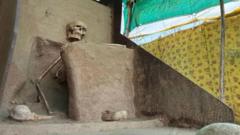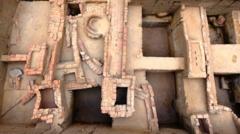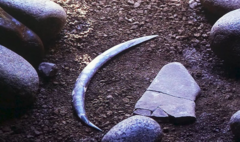After enduring bureaucratic delays and being exposed to the elements, a historical skeleton retrieved in Gujarat has been placed in a local museum where it will await public display and further examination.
Ancient Skeleton Finds Home in Museum After Six-Year Wait

Ancient Skeleton Finds Home in Museum After Six-Year Wait
A 1,000-year-old skeleton from Gujarat, India, has finally been transferred to a museum, ending its six-year period in limbo since excavation.
A 1,000-year-old human skeleton, excavated six years ago and discovered in a sitting cross-legged position, has found a new home in a museum in Vadnagar, Gujarat, India. The skeleton had been left uncovered in a makeshift shelter near the original excavation site since 2019, drawing criticism for its lack of protection and neglect due to administrative disputes.
On Thursday, the authorities successfully transported the skeleton a short distance to the Archaeological Experiential Museum, where it will undergo careful evaluation and preparation before going on public display. Mahendra Surela, the museum curator, assured that the transition was handled “with utmost care” and under the watchful eye of renowned experts, ensuring the skeleton's integrity remained intact during the move.
As it currently stands, the skeleton is situated near the museum's entrance, surrounded by a protective barrier, while plans for its final exhibition location are being devised. Surela noted that it might eventually be displayed on the second floor, alongside a photographic representation of the artifact.
Abhijit Ambekar, the archaeologist who unearthed the skeleton, expressed his relief that this significant finding is finally receiving deserved attention. He mentioned earlier that such remains have been discovered at only three other sites across India, marking it as a rare archaeological treasure.
While officials debated the future of the skeleton, it was vulnerable to the elements and unmonitored, highlighting a lack of sufficient administrative action. The skeleton is believed to date back to the Solanki dynasty, which reigned over parts of modern Gujarat from 940 to 1300 CE. Its remarkable preservation is attributed to the stable soil surrounding it and its burial position.
According to Mr. Ambekar, the skeleton may provide valuable insights into the ancient practice of "samadhi burials," which involved burying revered individuals rather than following the traditional cremation customs. The museum's commitment to the skeleton's preservation is a hopeful step in honoring and studying this significant aspect of India's rich historical tapestry.






















